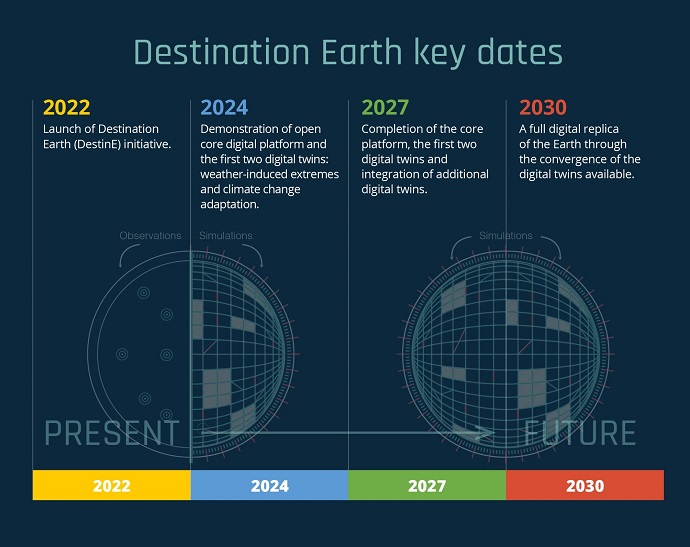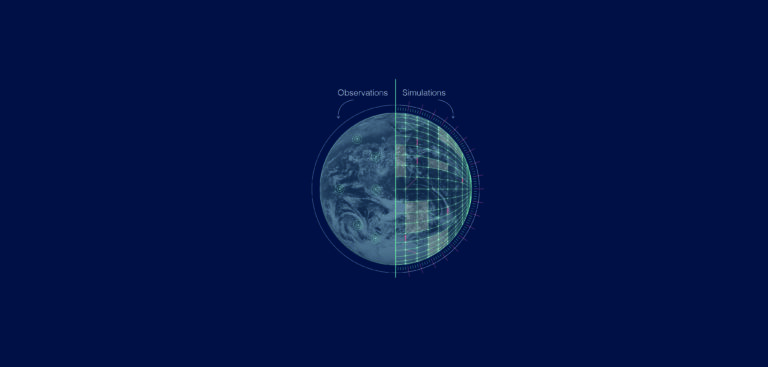The European Centre for Medium-Range Weather Forecasts (ECMWF) has committed to completing the first steps of the EU’s Destination Earth (DestinE) initiative by mid-2024. At this point, ECMWF will produce highly accurate replicas of Earth to facilitate action on climate change and environmental extremes.
Peter Bauer, ECMWF’s director of Destination Earth, commented, “By that time we expect to have developed demonstration products for the first two digital twins of the Earth system, which will support climate change adaptation policies and decision making to reduce the impacts of weather-induced extremes.”
Contracts to help deliver the two digital twins have been concluded with European organizations. Separate agreements for specific use cases and to ensure the digital twins can rely on sufficient computing power have also been reached.
DestinE has been developed since early 2022 by three pan-European organizations: ESA, which is to develop the core service platform; EUMETSAT, which will create a data lake; and ECMWF, which will set up the first two digital twins. ECMWF will also create a digital twin engine in support of accelerated computing and efficient big data analysis close to European pre-exascale supercomputers.

Two digital twins
At the core of ECMWF’s activities for DestinE until mid-2024 will be two digital twins. One of these is a digital twin on climate change adaptation to be delivered by Finland’s CSC – IT Center for Science.
CSC will collaborate with 12 partners, including national meteorological services, supercomputing centers and some of Europe’s top climate research institutions. They will provide a configurable climate information system performing multi-decadal global climate simulations at a resolution of 5km or less.
The other digital twin is on weather-induced extremes. It includes a global continuous component to be provided by ECMWF. This will focus on predictions of extremes a few days ahead, building on the center’s Integrated Forecasting System (IFS).
This digital twin will also feature an on-demand component to be delivered by Météo-France and partners from 22 European countries. It will rely on short-range predictions with a resolution between 500m and 750m, and even 200m depending on the situation, as well as extremes-type dependent configurability. These capabilities will initially be limited to Europe.
The digital twins will also be used to develop particular applications in different domains. “To us that was important as these built-in use cases can interact with Earth system models and have full access to the entire data stream as it is being produced – a capability which does not exist today,” added Bauer.
 Other use cases
Other use cases
To also support use cases for data users in different fields that mostly operate on Earth system models and observational output data, ECMWF has reached agreements with several European organizations, including:
- The Dutch institute for applied research in the field of water and subsurface, Deltares. It will develop a coastal forecasting and climate adaptation tool.
- The German Aerospace Center (DLR) and its Institute of Networked Energy Systems. They are to provide tools for power system operators seeking accurate, decision-ready data to ensure a reliable, optimized electricity supply to consumers.
- The German research center Forschungszentrum Jülich (FZJ). It will develop an interface for highly accurate, on-demand air quality analyses and forecasts based on machine learning and high-resolution Earth system models.
- The Belgian organization VITO for research on sustainable development. It will use the digital twins to provide current and future high-resolution urban heat maps for cities across Europe.
- The Finnish Meteorological Institute (FMI). It will develop an evolution of the Harvester Seasons seasonal forecast app based on the digital twins.
“The idea here is that access to the vast outputs of the digital twins can provide you with better-quality results and user application interactivity in domains that matter for society as represented by these partners,” said Bauer.
Supercomputing services
ECMWF has reached an agreement with the Italian computing center Cineca to facilitate the implementation of the digital twins in the European High-Performance Computing Joint Undertaking (EuroHPC JU). The Italian IT Services company Exprivia is to implement innovative visualization pathways, rendering and immersive technologies, and there is an agreement with the European Technology Platform for High Performance Computing (ETP4HPC) to cooperate on a strategy for specific digital technology to create digital twins and how DestinE can keep up with these developments.
At present, ECMWF and partners are developing a wider communication strategy and access points for updates on the activity, links to individual contributions, procured activities and partnerships also at international level.
Near the end of phase one, the three entities will produce an end-to-end system demonstration across ESA’s core service platform, EUMETSAT’s data lake and ECMWF’s digital twins and the engine.
Bauer said, “The production of the digital twins will remain distributed on different supercomputers, but the output will be made available through EUMETSAT’s data lake and ESA’s service platform. This will only be fully implemented after 2024, once we have presented our first demonstration products.”
To learn more about the EU’s Destination Earth initiative, view our cover story from the September issue of Meteorological Technology International by clicking here.
This article was originally posted on the ECMWF website, and can be viewed here.
Headline and opening paragraph adapted to suit the Meteorological Technology International website. Content shared under Creative Commons — Attribution 4.0 International — CC BY 4.0



